¿Qué es una URL Slug? 5 consejos para mejorar el SEO que debe conocer
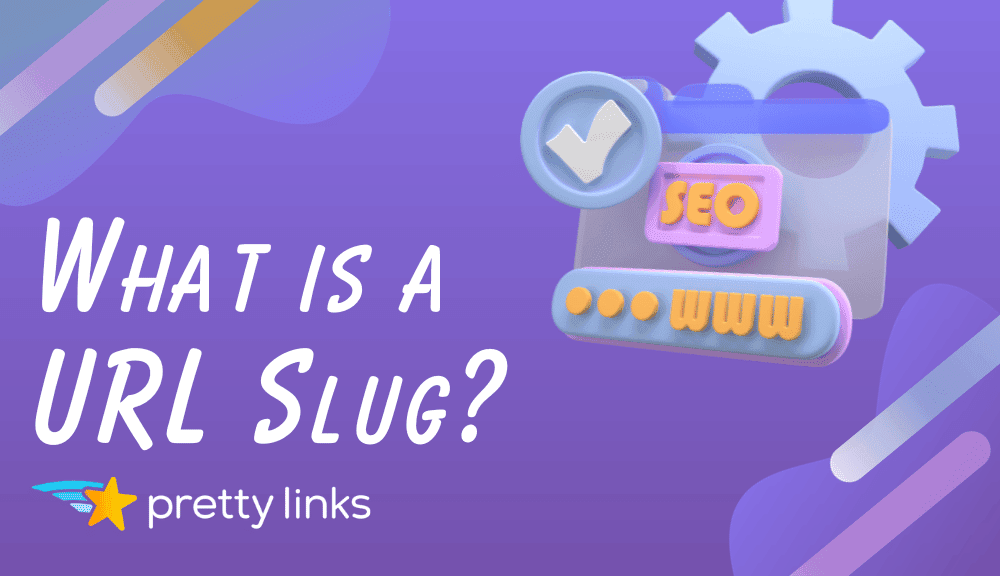
Contenido
Los enlaces son las autopistas del marketing en línea, ya que actúan como vías digitales que conducen a los clientes potenciales hasta su puerta virtual o, en el caso del marketing de afiliación, hasta sus socios comerciales.
Pero no todos los caminos son fáciles. Un enlace poco claro o desordenado puede actuar menos como una vía rápida y más como una barricada que disuade de hacer clic.

Considere optimización de los slugs de URL as your roadwork for the digital age, replacing that scribbled-out map with a high-res GPS. This doesn’t just clean up your links; it’s a strategic move that cultivates trust, encourages clicks, and fuels conversions.
In this blog post, we’re peeling back the layers on URLs, explaining why they’re so vital for your online success. Then we’ll walk you through the slug customization steps using the ever-so-handy Pretty Links tool, including 5 tactical tips to help you optimize your links like a pro.
¿Qué es una URL Slug?
A URL slug is more than just a string of characters; it’s a vital component in la arquitectura de cualquier sitio web. Se sitúa justo después del nombre de dominio en la dirección web y sirve como etiqueta clara y descriptiva de la página o contenido específico al que se dirige el visitante.
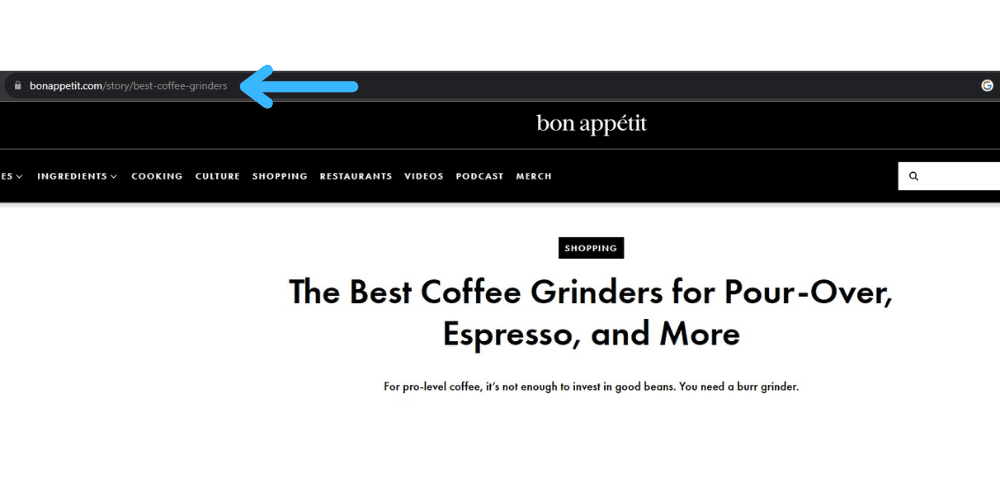
Por ejemplo, en "https://www.bonappetit.com/story/best-coffee-grinders,” part of the URL slug is “best-coffee-grinders”. As you can see, it’s usually a string of words or numbers separated by hyphens to make it readable and SEO-friendly.
La importancia de las babosas de URL
- Beneficios SEO: Search engines like Google love URL slugs that are descriptive and relevant to the page’s content. This means a good slug can help your page rank higher in search results.
- Experiencia del usuario: A well-crafted slug gives your audience a clue about what they’re clicking into.
- Compartibilidad: URLs limpias y descriptivas más compartible, whether it’s in a text message or a Tweet.
¿Qué es una URL de afiliación?
Si se dedica al marketing de afiliación, then you’re no stranger to affiliate links. These aren’t just any URLs; they’re specialized web addresses that perform a dual role.
En primer lugar, guían a su público hacia contenidos o productos específicos. En segundo lugar, llevan un identificador único -esencialmente una etiqueta de nombre digital- que garantiza que el vendedor afiliado reciba el crédito por cualquier clic o venta generados a través del enlace.
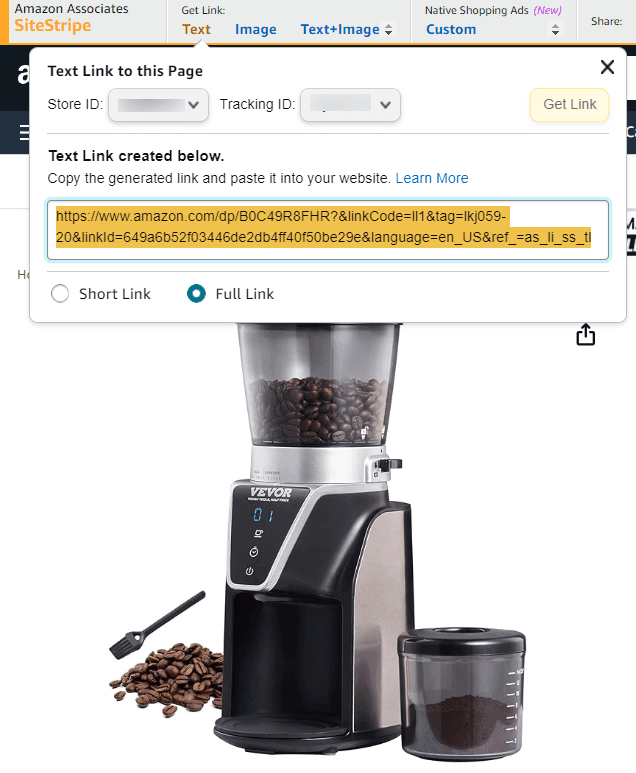
Affiliate links might be your ticket to earning some cash, but let’s face it, they’re often long and cluttered, which can be a click-repellent for your audience.
With the help of Pretty Links, you can transform those unwieldy URLs into short, eye-catching links. And don’t worry, this makeover doesn’t mess with the essential tracking features needed by merchants. So you keep raking in those commissions while offering cleaner, more clickable links to your audience.
El significado de Optimizado Enlaces de afiliados
- Aumentar las conversiones: Un enlace claro y descriptivo puede hacer que la gente haga clic. Nadie quiere hacer clic en un enlace que parece un amasijo de caracteres aleatorios.
- Confianza y credibilidad: Una babosa de fácil lectura muestra you’re not hiding anything. People are more willing to click on something when they know what they’re getting into.
- Análisis avanzados: When you use a customized slug, it’s easier to track the performance of individual links. That’s crucial info for refining your marketing strategies.
Mientras que los slugs de URL se centran en mejorar la navegación del usuario y el SEO, los slugs de enlaces de afiliación añaden otra capa al ayudarle a monetizar su marketing digital. Ambos son esenciales para maximizar el potencial de su presencia en internet.
Cómo optimizar sus babosas URL con Pretty Links
Like we mentioned earlier, the default slugs that come with your URLs (especially affiliate links) usually don’t do them justice. They can be long, confusing, or just plain forgettable.
That’s why customizing your URL slugs to make them more succinct and relevant is a smart move. Enter Pretty Links, a handy tool that makes this process possible.
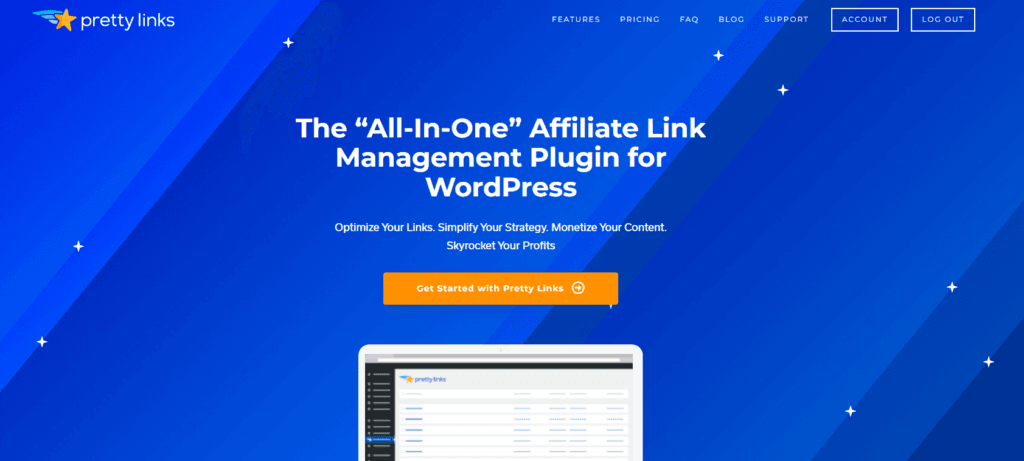
Una vez que instalado y activado Pretty Links on your website, just head over to the Pretty Links tab in your WordPress dashboard. From there, you’ll find an “Add New” button at the top. Go ahead and click it.
Antes de añadir un slug personalizado, hay que tomar otras decisiones. Por ejemplo, tendrá que decidir el Tipo de redirección y conecte el URL de destinoque es el enlace original, no tan bonito, que quieres reemplazar.
Once that’s squared away, it’s time for the main event: adding your customized slug into the Enlace bonito field. What you put here will depend on your link’s role, so make it count:
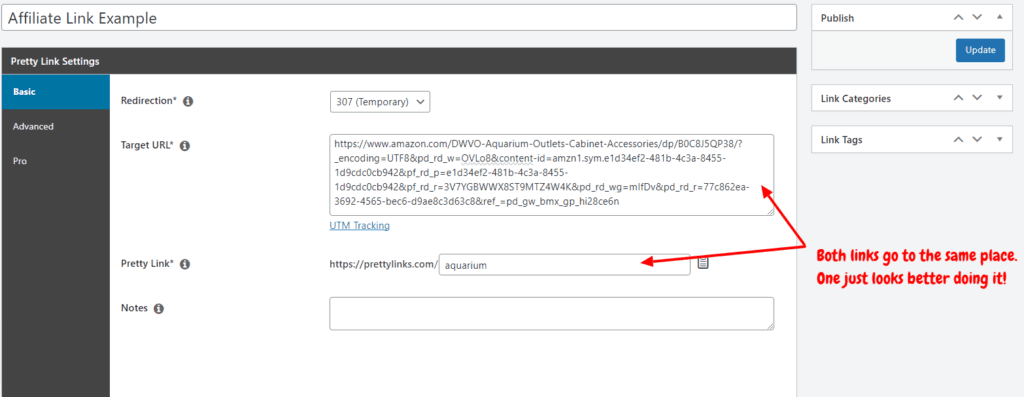
Hit “Update”, and voila! Your new, optimized link is ready for action. And since we’re on the subject, stay tuned for some nifty tips on how to craft slugs that really hit the mark.
Cómo crear la URL definitiva: 5 consejos profesionales para un viaje más fluido
Designing the perfect URL slug isn’t just a task you can mindlessly check off; it’s like plotting a route that leads users right where you want them.
Here are 5 tips for creating URL slugs that won’t just get glanced at, but clicked on.
1. Corto y sencillo
Even though there’s no set speed limit – err, I mean length limit – for your slugs, lo corto suele ser más dulce. They’re easier to remember, easier to share, and simply get the job done.
Here’s how you can keep your links short, but still tell the full story of your content:
- De 3 a 5 palabras: Google’s Matt Cutts recommends keeping slugs between three and five words to ensure they’re fully visible on Páginas de resultados de motores de búsqueda (SERPs).
- Don’t Include Palabras clave: Los motores de búsqueda suelen ignorar palabras como "y", "o", "pero" y "el". Elimínelas y su babosa será instantáneamente más ágil y eficaz.
Follow these tips, and you’re well on your way to crafting URL slugs that not only catch the user’s eye but also get a nod from search engines.
2. Incorporar palabras clave
La incorporación de palabras clave de destino en los slugs de URL le da ese extra oomph para escalar posiciones en las búsquedas. Estas son las frases mágicas que atraer a los visitantesy, básicamente, conseguir que su contenido reciba la atención que merece.
Choosing the right keywords isn’t rocket science, but you’ve got to be smart about it. You want words that su público está escribiendo en esa barra de búsqueda.
¿Cómo te das cuenta? Me alegro de que preguntes.
- Haga los deberes sobre las palabras clave: Utilice herramientas como Planificador de palabras clave de Google AdWords to find out which terms your audience is actively looking for. Don’t make it a guessing game; easily get data to help you choose wisely.
- Palabras clave de cola larga: Estos son los frases de palabras clave más largas y específicas that people are likely to use when they’re closer to making a purchase. They help you rank higher and give people a better idea of what your content is about.
- Pruebas A/B para los inseguros: If you’re scratching your head over which keyword will really hit the mark, try some pruebas divididas. De este modo, podrá ver el rendimiento de las distintas palabras clave y dejar que su público elija la ganadora por usted.
With these pointers, you’re set to create URL slugs that resonate with your audience and make search engines very, very happy.
3. Amplíe su alcance: A escala local y mundial
You’re savvy enough to know that SEO is a must, but have you tapped into the power of location-based SEO? Enter the world of geographic SEO, an essential but often overlooked strategy for boosting your affiliate links to a global audience.
Con sólo modificar los slugs de su URL, puede dirigirse a clientes potenciales desde Nueva York a Nueva Delhi.
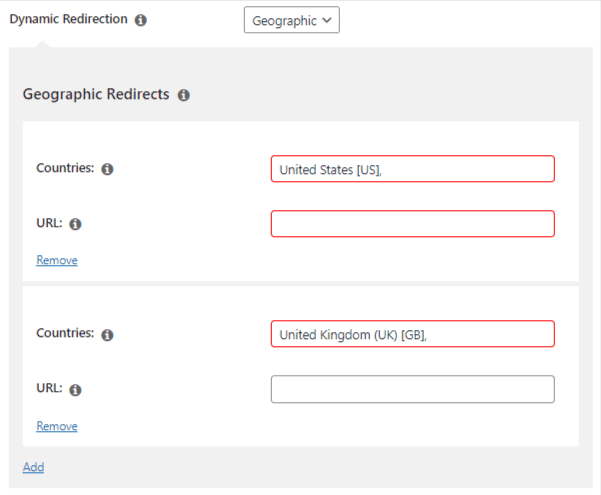
Pretty Links Redirecciones geográficas son el truco perfecto para conseguirlo, sobre todo si se combinan con este trabajo previo:
- Mapa de mercados clave: Haga un estudio de mercado para determinar dónde vive su público objetivo. ¿Son sus servicios o productos especialmente populares en determinadas regiones o países? Haga una lista y utilícela para orientar su estrategia.
- Añada una pizca de localismo: Si tiene sentido, incluya el nombre de la ciudad o región en el slug de su URL. No sólo localiza el enlace, sino que lo hace inmediatamente relacionable. Por ejemplo, un slug como "kansas-city-chiefs-merch" sería bastante sencillo.
- Don’t Forget Mobile: Muchas búsquedas locales se realizan en dispositivos móviles. Un slug de URL complejo o demasiado largo puede resultar desalentador en una pantalla pequeña. El slug de tu URL debe ser corto y ágil para que se vea bien y se pueda hacer clic fácilmente en pantallas pequeñas.
- Redireccionamientos Geo-IP: If you’re in the mood to go full techie, Prety Links ofrece redireccionamientos Geo-IP. Your link will automatically whisk the user away to their local version of the website based on their IP. Though it doesn’t change the slug, it makes your local-centric approach even more effective.
Añada algunas localizaciones geográficas específicas a sus enlaces de afiliación y no sólo jugará a escala local, sino mundial.
4. Mantenga sus enlaces creíbles y dignos de clic
So, you’re getting the hang of adding keywords and keeping things short and snappy. Awesome! But wait a minute, not so fast. Even with the best intentions, it’s easy to unknowingly set off some red flags que hacen que sus babosas URL parezcan sospechosas o menos creíbles.
Yep, there are some no-nos you’ve got to sidestep when it comes to your URL slugs, such as:
- Evite el lenguaje comercial: Words and phrases like “Free”, “Buy Now”, “Discount”, or “Last Chance” might send your URLs straight into spam territory, especially if you’re sending these out in email campaigns.
- No Clickbait, por favor: It’s tempting to make your slugs sound super exciting, but if they over-promise and under-deliver, you’re only going to disappoint visitors. So, let’s keep things honest and true to the content.
- Di no a los caracteres especiales: Symbols like &, %, or $ aren’t just visually jarring; they also trip up search engines. Keep it neat with just letters and hyphens for a user-friendly and search engine-friendly slug.
- Cuidado con las capitales: Las URL distinguen entre mayúsculas y minúsculas. Las mayúsculas pueden llevar a sus visitantes por el camino equivocado o, peor aún, a una página de error. Por lo tanto, mantén un perfil bajo con todas las minúsculas.
By being mindful of these red flags, you’ll ensure your URL slugs are not only effective but also trustworthy. That means better clicks, better shares, and an overall better reputation.
5. Babosas URL artesanales que resisten el paso del tiempo
Una buena URL también es atemporal. Lo último que quieres es encontrarte revisando y ajustando viejos slugs porque de repente parecen anticuados o irrelevantes.
Entonces, ¿cómo crear babosas de URL que resistan el paso del tiempo?
- Sáltese las tendencias: Today’s buzzwords might be tomorrow’s eye-rollers. Stick to slugs that offer a straightforward description of your content.
- Sé prudente con las citas: Unless it’s vital for context (like an annual report or event), try to avoid embedding dates in your slugs. They can make even contenidos perennes parecen anticuados.
- Preparación para la redirección: La vida pasa, y puede que necesites actualizar una babosa en algún momento. Si llega ese día, tenga una estrategia de reorientación in place to funnel traffic from the old URL to the new one. This way, you won’t lose the SEO juice you’ve built up over time.
By embracing these future-oriented approaches, you’re not only optimizing for today, you’re laying a solid foundation for the web users of tomorrow.
Conclusión
Los enlaces son como las señales de tráfico en la autopista de Internet. Una URL mal diseñada es similar a una señal de tráfico poco clara. Nadie quiere tomar ese desvío. Sin embargo, un slug cuidadosamente construido se convierte en su brillante cartel de neón, invitando a más clics, generando confianza y elevando su juego SEO.
En este post, te hemos mostrado cómo añadir slugs de URL personalizados utilizando Pretty Links. También hemos compartido 5 consejos para crear las babosas más eficaces, incluyendo:
- Sea breve y rápido
- Aprovechar las palabras clave
- Go Local, Go Global
- Navegar entre banderas rojas
- Construir babosas a largo plazo
It’s not just about following a checklist; it’s about understanding your audience, knowing what makes them click – literally – and adapting as you go. After all, the digital world is always changing, but a solid, well-thought-out slug: That’s a keeper.
Si te ha gustado este artículo, no dejes de seguirnos en Facebook, Twitter, Pinteresty LinkedIn! And don’t forget to subscribe in the box below.
¿Tiene alguna pregunta sobre la optimización de los slugs de URL o sobre cómo puede ayudarle Pretty Links? Háganoslo saber en la sección de comentarios.
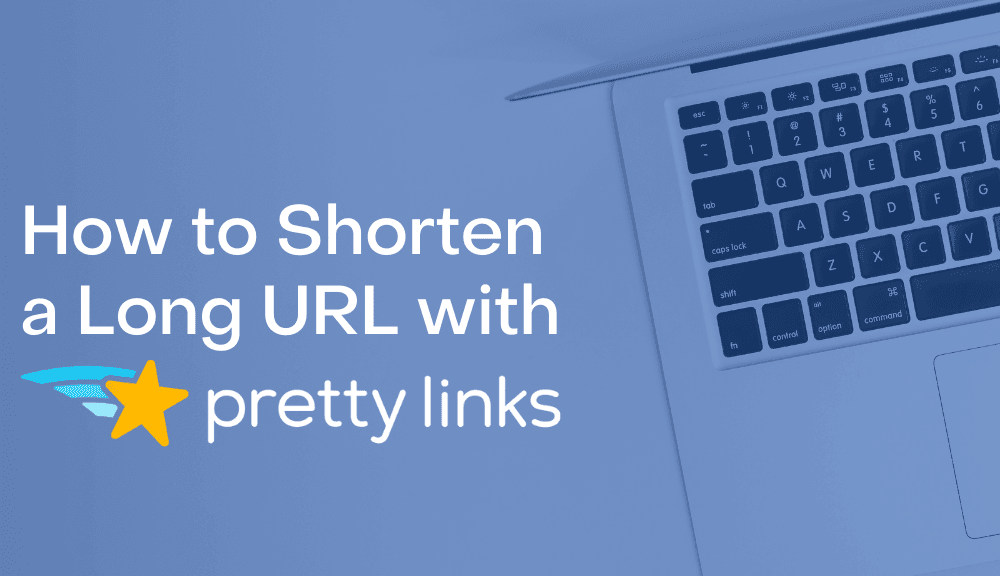
Bill Conrad
2 de marzo de 2018
Excelente post. Me ayudó a entender mejor "long slugs 3 a 5 palabras" y es una buena referencia para sus clientes.
John Hughes
12 de marzo de 2018
Hola Bill. No hay de qué. Me alegro de que te haya resultado útil.
jeisonrincon
20 de marzo de 2018
me estoy registrando por que quiero aprender
Marshall Pratt
29 de enero de 2019
Gracias John.....Nicely explicó artículo....I'm sólo un poco confundido entre URL y babosa. Este artículo acaba de soplar mi confusión de distancia.
John Hughes
4 de febrero de 2019
¡Me alegro de haberte ayudado, Marshall!
Diseños Saksham
16 de diciembre de 2021
Gracias, John, Me gusta tu post sobre URL slugs